|
OIL SHOCKWAVE:
Torrance, CA Emergency Simulation Targets Big Business
and Local Government Managers
Ominous Timing in Advance of Hurricane Katrina
by
Zac Evans and Michael C. Ruppert
© Copyright 2005, From The Wilderness Publications, www.fromthewilderness.com. All Rights Reserved. May be reprinted, distributed or posted on an Internet web site for non-profit purposes only.
September 1, 2005 1030 PST (FTW) – On August 17th, little more than a week before Hurricane Katrina captured our attention, Securing America’s Energy (SAFE) and the National Commission on Energy Policy (NCEP) held their third Oil Shockwave event in three months in Torrance, California. Torrance was appropriately chosen as it is home to 36% of California’s refining capacity and is home to both LA International airport and much of Southern California’s aerospace industry. Dubbed an “oil crisis simulation,” Oil Shockwave addressed the precarious nature of U.S. oil dependence via mock cabinet meetings wherein both current and former government officials played roles as key cabinet members, discussing how to advise the president in the midst of an escalating energy crisis caused by terrorism or political unrest – not, as the title of the event might suggest, problems caused by a dwindling supply of oil.
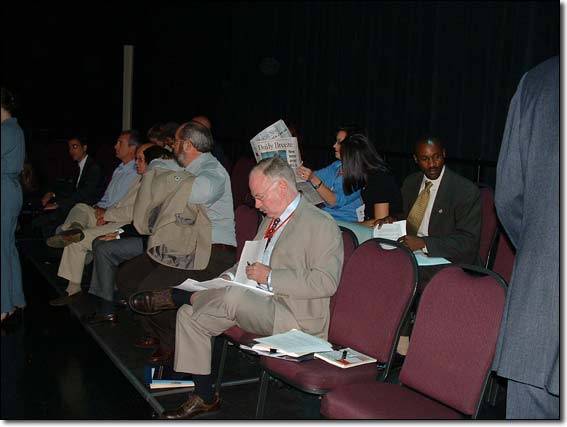
This was a big-budget event, complete with simulated and slickly produced CNN-like broadcasts of developing news and carefully scripted roles for each of the key participants. Perhaps most revealing was the fact that this was not an event aimed at the general public. The live audience of about 100 was mostly local government officials and executives of major corporations. This suggested to FTW that these events have been early-warning fire drills for specific key localities throughout the nation as the first big hits from Peak Oil draw near.
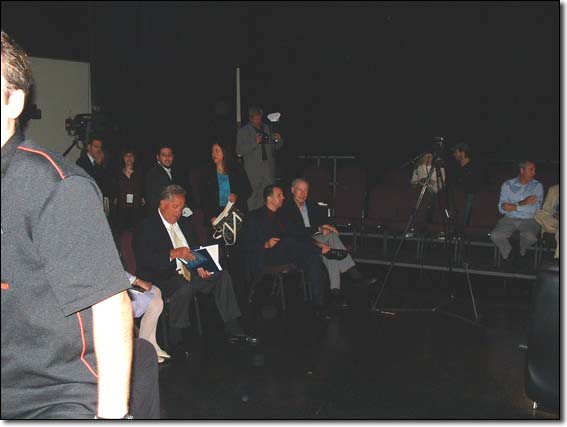 |
| This was not a general public audience. |
The actors at the Torrance event included: R. James Woolsey, former Director of the Central Intelligence Agency (as National Security Advisor); Rand Beers, President of the Coalition for American Leadership & Security and former Special Assistant to the President and Senior Director for Combating Terrorism (as Secretary of Homeland Security); Robert E. Grady, Managing Partner, Carlyle Venture Partners, the first of two U.S. venture funds of the Carlyle Group (as Secretary of Treasury); Congresswoman Jane Harman of California’s 36 th Congressional District (as Secretary of Defense); Mary Nichols, Director of the Institute of the Environment at UCLA and former Assistant Administrator of the Environmental Protection Agency (as Secretary of Energy); Matt Peterson, President and CEO of Global Green USA, and member of the Council on Foreign Relations (as Secretary of the Interior); Dr. Steven Spiegel, Director of the UCLA Burkle Center Mideast Regional Security Program (as Director of National Intelligence); and Pete Wilson, former governor of California (as Secretary of State).
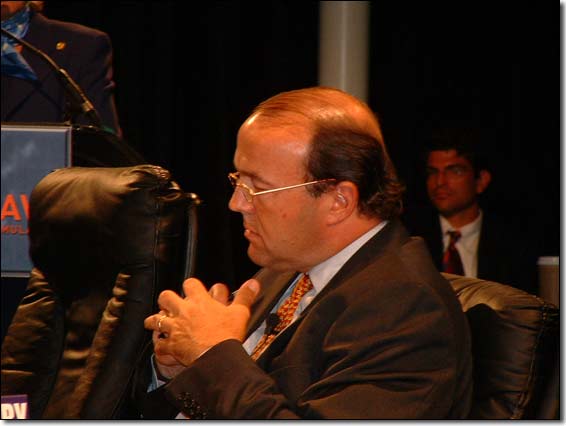 |
The Carlyle Group’s Robert Grady (Treasury Secretary) looking appropriately reflective |
Harman, who was the host of the event in her congressional district boasts some other interesting credentials. She is the ranking Democratic member of the House Permanent Select Committee on Intelligence (HPSCI) and her district is also home to 36% of all refineries in the state of California. Harman was also sitting on the dais in 1996 when FTW Publisher/Editor Mike Ruppert had his now-infamous confrontation with then-CIA Director John Deutch over the agency’s involvement in drug smuggling into the US.
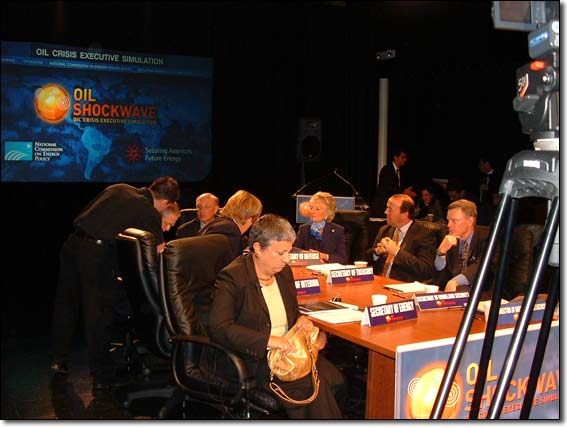 |
| Seated at table, clockwise from lower left: 1) Secretary of Energy Mary Nichols, Director of the Institute of the Environment at UCLA; 2) Matt Peterson, President and CEO of Global Green USA, and member of the Council on Foreign Relations; 3) Pete Wilson, former governor of California; 4) R. James Woolsey, former Director of the Central Intelligence Agency; 5) Jane Harman, Member of Congress from California's 36th Congressional District; 6) Robert E. Grady, Managing Partner of Carlyle Venture Partners (of the Carlyle Group); 7) Rand Beers, President of the Coalition for American Leadership & Security; 8) [not visible] Dr. Steven Spiegel, Director of the UCLA Burkle Center Mideast Regional Security Program. |
The setting for the simulation began in December 2005 and ended in July 2006. During that time situations were provided to the panelists through simulated news broadcasts and notes given to them throughout by event moderators. As the simulation unfolded there were bombings of oil facilities in Saudi Arabia and Alaska; civil unrest in Nigeria; instability in Iraq; and stagnation of Russian oil production. Consequently the price of oil rose…and kept rising mercilessly, eventually breaking $100 per barrel. The solution to the tightening economic vise-grip was simple enough, according to the panelists: Increase Supply, Reduce Demand (demand destruction was not specifically mentioned), and Develop Alternatives. While the What and Why are easy-enough to see in this context, the panelists all agreed that the How was another matter -- although the display line of Honda and Toyota hybrids in the venue’s parking lot (the Torrance Civic Center), along with rows of booths manned by representatives of the renewable energy industry in the courtyard suggested otherwise.
OVERLY SIMPLE SOLUTIONS, FAULTY ASSUMPTIONS, OR BOTH
Plenty of short-term solutions were casually suggested as possible means of weathering the storm caused by any one of the problems presented during the Oil Shockwave brainstorm.
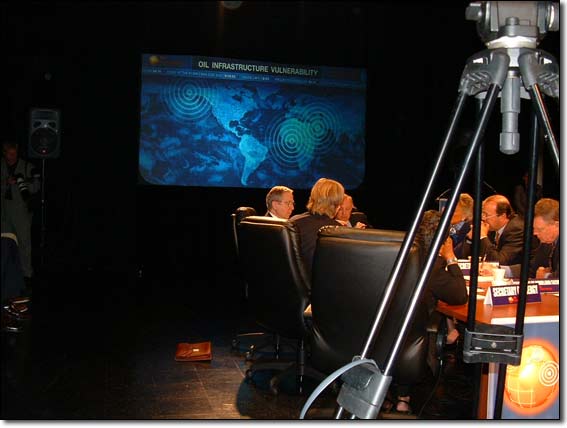 |
| What’s missing from this slide? |
Since terrorism and political strife were accepted as the root causes of the imagined oil supply disruption (as opposed to Peak Oil), the message was simply this: the United States must find a way to become more self-sufficient energy-wise in order to avoid the economic rollercoaster that it’s currently on due to its dependence on oil from unstable nations. It stood to reason – from the panelists’ perspective – that in this context a little fine-tuning of the public and corporate consciousness, and a broadening and reallocation of investment, are all that’s needed.
From FTW’s perspective, such an approach is both futile and recklessly dangerous. For example, in response to political unrest in Nigeria the pseudo-cabinet acted as though a simple request to Saudi Arabia to increase oil production would be adequate for the time being. It was asserted that this was possible because the Saudis had already stepped up production and had given every assurance that they would be able to continue doing so. The panel left no room for the contingency that the Saudis simply could not increase production, except in case of a terrorist attack to one or more refineries — rather than a lack of reserves, or collapsing reservoirs.
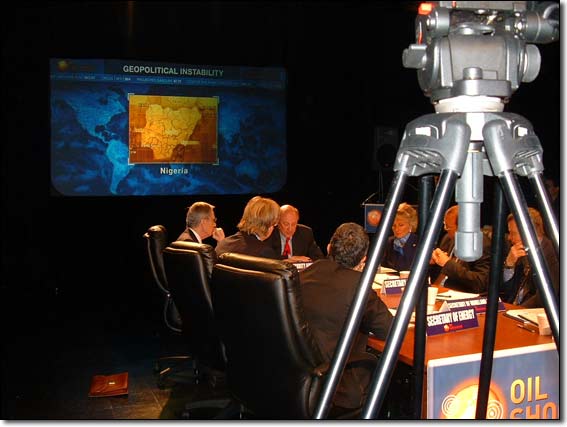 |
| Nigeria unrest makes a bad situation worse. |
The solution to the Nigeria crisis was three-pronged. One prong was the request to the Saudis; the other two were tapping into the Strategic Petroleum Reserve ( SPR), and the consideration of military options. In this context, the SPR (called “Spro” by the participants), although possessing as little as sixty days worth of oil for the entire country, would best be used for a rainy day such as this, and be built back up again in brighter days. Military options, too, could calm the choppy waters, stabilize affected regions quite effectively, and get oil production back on line and humming. One need only observe the current situation in Iraq to be thoroughly unconvinced of this.
The Artic National Wildlife Refuge (ANWR) was another ace up the cabinet’s sleeve. Although ANWR is the only oil deposit in the United States that has not been drilled, as federal law prohibits doing so, the cabinet refused to take that option off the table, seeming to regard the Alaskan field as one of the true saviors in the game. For this to be the case, ANWR would have to hold at least 17 billion barrels (Gb), which is the most liberal estimate of actual reserves cap there. Most experts place Ultimately Recoverable Reserves in ANWR at around 3-5 billion barrels – a six month supply for the US. However, even if the wildly optimistic figure is correct, the cabinet failed to take into account the time and money needed to establish the operation necessary to extract, pump and deliver this oil – years. Therefore, ANWR is no quick fix for anything.
ULTRA FUEL-EFFICIENT CARS, TRUCKS… AND TANKS?
James Woolsey doesn’t have just one hybrid car, but a few. Rep. Jane Harman drove hers to the Oil Shockwave event. They practice what they preach; maybe they’re onto something. Woolsey uses solar panels on his house. In fact, his whole house is one big freaking solar panel; he was, after all, the Director of the CIA – whose intense focus on Peak Oil goes as far back as the 1970s (FTW has established as much through declassified documents). Coincidentally, Harman mentioned that she had just driven from her full-solar home in Venice, California. At the event, FTW also noted that several Coca-Cola bottling plants have already gone solar. We may be starving and freezing with Peak Oil but there will always be a Coke around.
Knowing that George Bush, Al Gore, and Dick Cheney also have complete off-grid, solar-powered rural residences we might conclude that this is a clue that they know something they aren’t telling us.
Probably the most often-mentioned solution to the pickle of the Oil Shockwave event was the hybrid car. Cars that run on any combination of hydrogen, natural gas, and electricity, either exclusively or cooperatively with gasoline, would lower emissions and definitely decrease consumer and corporate fuel consumption. Hearing this outside of the context of real life, stated simply and confidently by the cabinet members, one could very easily leave the “board room” full of hope for the future and all our progeny present and hereafter, walk outside to the courtyard, and have a very lively conversation with any one of the representatives from Honda who are there purely to serve you.
But there’s a lot they didn’t tell us.
Amid all the mentions of hybrid technology, not once were the true energy economics of that technology articulated. In the context of a fuel crisis, real or imagined, as in the case of Oil Shockwave, a hybrid car is no panacea. It takes an average of 2500 gallons of oil to make one mid-sized hybrid car. Ore must be mined, transported, smelted and formed. Most of the body, interior, and some of the parts are all petro-chemically based (i.e. plastic) – not to mention the energy expended in the actual production of the vehicle. In the city, the hybrid enjoys the highest fuel economy, as the constant use of the car’s brakes keeps the battery charged. But on the highway, over long distances, the hybrid is the least fuel efficient because the brakes are engaged so rarely.
An interesting (and possibly quite telling) suggestion by Rep. Harman was that it would be a good idea to overhaul the entire military fleet with hybrid vehicles. We wonder how much that would cost and whether it wouldn’t be a boondoggle for failing US automakers while actually increasing oil consumption.
What would happen to all the surplus vehicles? Wouldn’t they be auctioned off and actually increase the number of vehicles out there as they wind up on the road?
There is not, at this time, any legislation that is proposing any such thing and there is a good reason for that. Not surprisingly, the military, particularly the Army, has been experimenting with the concept of hybrid light-armored vehicles for years. The hybrid is a very appealing prospect for the military, as the relative quiet of the propulsion system (compared to that of a diesel-powered truck, for instance) would impede detection in the field. The problem is that the battery’s cells run low and have to be recharged about every hundred miles. Batteries are also sensitive, toxic and degenerative. They suffer a reduction in energy carrying capacity over time. The current opinion of the Army is that the technology is too immature. At the current rate, the Army expects to produce a workable light armored hybrid vehicle by 2012. So much for that solution.
Although open to the public and the press, it was clear where Oil Shockwave’s advance announcements were targeted. The event was held in a small off-off-Broadway-sized theater at the Torrance Convention center, of which the maximum capacity was between 75 and 100. At least six news cameras stood at the back of the small room, each with an attendant reporter, producer, and camera man. There were print reporters and at least one news photographer.
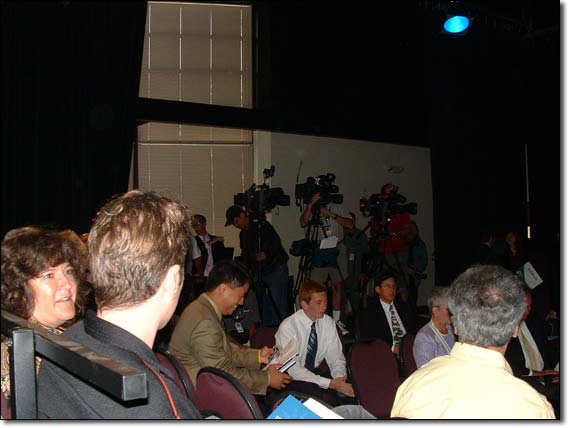 |
| Lots of mainstream press but little real effort. Independent journalist Lisa Pease at far left. |
After the event, a press conference was held amongst the hybrid cars on display, and when it came time for the Q&A no one from the mainstream press had anything to ask. Standing at the front of the press line, FTW Publisher Michael Ruppert raised his hand and asked the first question:
“Congressman Roscoe Bartlett of Maryland has delivered eight special-order addresses on the floor of the House about Peak Oil. I met with him in his office in Washington two months ago, after which he had a private briefing with President Bush where he took some material I had prepared. We have a report from Science Applications International Corporation, February of this year, at White House direction on the subject of Peak Oil and recently in the House Armed Services Committee, as they discussed CNOOC’s suggested purchase of Unocal, the term Peak Oil was thrown about in very candid terms in an open-house hearing. Peak Oil seems to be overriding what I see here as an attempt to blame Saudi Arabia for not producing more oil when in fact there may be no more oil to produce and these shortages may be inevitable anyway. How does the panel react to that?”
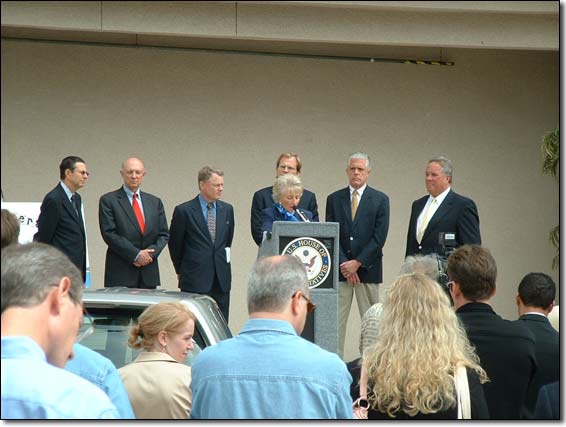 |
| The press conference begins. |
In response to Ruppert’s question Woolsey acknowledged the concept of Peak Oil with a nod to M. King Hubbert, who in the 1950’s had accurately predicted when the peak of oil production in the U.S. would occur. Concerning Saudi Arabia, Woolsey made reference to a recent report that concluded “that the Saudis may, in their huge fields, be at a point such that they are either approaching very soon or even have already approached such peak production, but you need to realize what that means.”
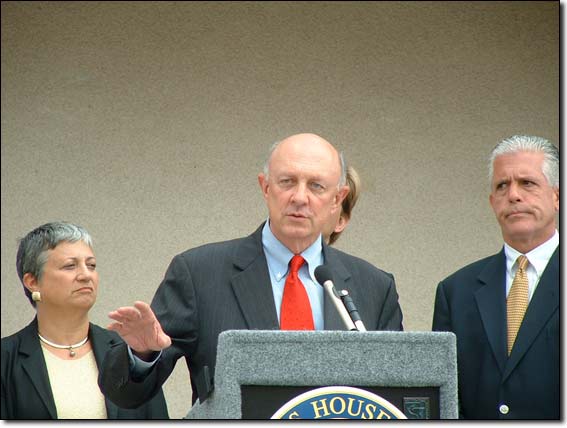 |
| Woolsey responds to Mike Ruppert’s question. |
Woolsey continued, “Since oil production costs are so low in Saudi Arabia, at most a few dollars a barrel, it may well be the case that a field hits its peak and production costs go up substantially, but that just means they’re going up to five, six, seven, eight dollars a barrel instead of something huge. So even if the fields of the Persian Gulf and the Middle East, particularly in Saudi Arabia, are coming to peak production, this may not substantially affect the fact that Saudi Arabia and the Gulf will still be the low cost producers in the world and we’re all still be more and more dependant on them as time goes on; however expensive they get to be in the near term, it’s not going to be as expensive as production in, say, Russia which is hindered by lack of pipelines, by cold weather, and the rest.
“I know Congressman Bartlett, I think very highly of him, I think his concern about peak production, which I talked with him about, is well taken, it’s an important issue, but it doesn’t negate any of the things we were saying in here, this morning, about what could come from an immediate crisis. We may have a chronic problem with peak production, and an acute problem with respect to near-term terrorist attacks.”
Rep. Harman agreed: “I would just say after that it points out the importance of accurate, timely, and actionable intelligence, which hopefully we’ll begin to field in larger amounts now that we have set up the Director of National Intelligence function.”
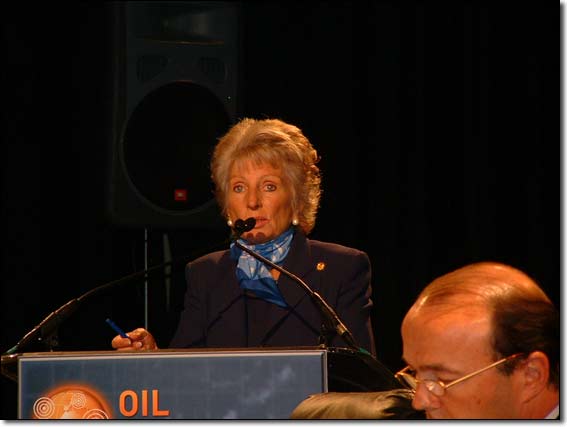 |
| Jane Harman delivers predictable “solutions” at the end of the drill. |
Immediately after the Press Conference all in attendance were invited to stay and inspect the cars on display and visit the booths in the courtyard. Lunch was provided.
Having just made his way off stage, Woolsey found himself face to face with Ruppert.
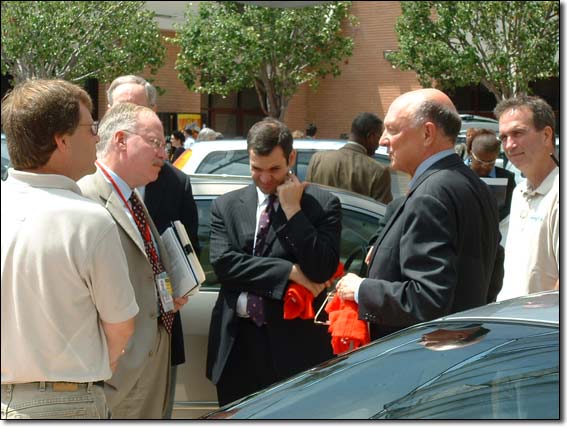 |
| Mike Ruppert meets his second DCI face-to-face. |
After laughing uproariously as Ruppert reminded him that he was the former LAPD narcotics investigator who had confronted his predecessor, John Deutch at Locke High School, Woolsey reiterated, “I do think the world outside the Middle East is going to hit peak sometime between now and a decade from now. The Middle East – God knows! – may have already hit, or it may be a while, but whatever happens we’re going to be so – in that regard – so damn dependant on them that we have to fix this problem. So whether you come at it because you’re concerned about Peak Oil… or terrorism, or global warming – you end up in the same place.” ( Listen here) Listen here)
Really, Mr. Woolsey? Do we?

Please Note
This function has been disabled.
|
|
|
|



